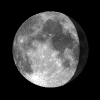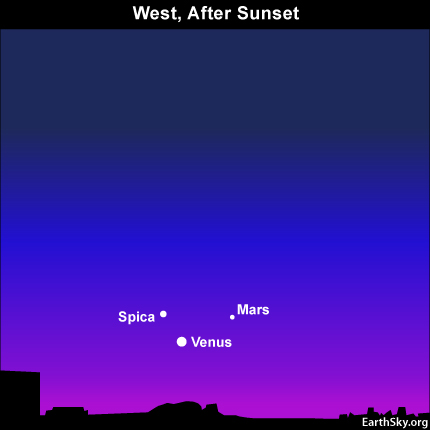Courtesy of EarthSky
A Clear Voice for Science
www.EarthSky.org

 In a few more days, Venus and Mars will team up with the star Spica to stage this year’s closest celestial trio – three heavenly bodies fitting within a circle smaller than 5 degrees in diameter. A typical binocular field covers about 5 degrees of sky, and you might catch all three snuggling within a single binocular field this early evening.
In a few more days, Venus and Mars will team up with the star Spica to stage this year’s closest celestial trio – three heavenly bodies fitting within a circle smaller than 5 degrees in diameter. A typical binocular field covers about 5 degrees of sky, and you might catch all three snuggling within a single binocular field this early evening.
As seen from North America, the threesome cozies up even more closely on Sunday evening, and closest yet on Monday evening. If you don’t see the trio in the same binocular field after sunset today, try again on Sunday and Monday. Watch as the planets do-si-do with Spica over the next several evenings.
Unfortunately for the northern hemisphere, the threesome sets at very early evening. From mid-northern latitudes, the whole kit and caboodle sets 1.5 hours (or less) after the sun. Dazzling Venus is easy to see, but Mars and Spica tantalize at the threshold of visibility. The best viewing window opens up from around 45 to 75 minutes after sunset. Have binoculars handy!
After the trio sets in the west, look for the blazing planet Jupiter to rise in the east. After rising, this wonderfully brilliant world will be out all night long!
Related:
Looking for a sky almanac? EarthSky recommends . . .
Written by Bruce McClure
Astronomy Picture of the Day from NASA/JPL
U.S. Naval Observator Astronomical Information center
The York County Astronomical Society